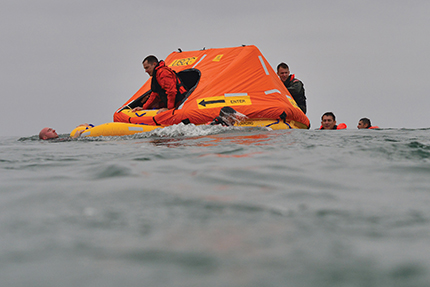(published April 2017)
With sea boots and foul weather gear full of water, I stepped onto the bottom rung of the life raft’s boarding ladder and tried to stand up. Nothing.
Groping at the inside of the raft’s door, I urgently searched for a handle that I knew was there but couldn’t see. When I finally got ahold of it, I was able to use the ladder and my upper body strength to make some headway through the door. The only problem? My inflated PFD was so big it kept getting caught as I tried to climb in.
After multiple attempts, and in a moment of frustration and desperation, I gave it one big pull with my arms and push with my legs. I was in.
Water came into the raft with me and I laid on the rubber floor for a few moments to compose myself and catch my breath. Being the first one in the raft of six, I then turned and helped the next person up and over. It was a struggle. And more water came in.
By the time all of us had been hoisted in the appropriately sized ocean life raft, the water was deep, there was very little room and everyone was panting like they had just completed a rigorous workout. I guess we had. But it was an experience that was humbling and immensely educational.
Fortunately, we were in a swimming pool in Vancouver, Washington on the second day of a U.S. Sailing Safety at Sea Seminar (SAS) put on by The Sailing Foundation. This was the first time I’d done this course and to say it was a learning experience would be an understatement.
Knowing your boat’s life raft was a key point of this exercise. When you get it serviced, don’t just drop it off. Watch it being inflated and learn where the handholds are and how to get in it. Take an inventory of what’s inside and cross reference that with your boat’s ditch bag. Speaking of ditch bags, don’t overdo it. People think they need to bring a lot of stuff with them in the raft but they don’t realize that there isn’t much room. Also, it’s very unlikely that you’ll even be in the raft long enough to use what you’ve brought.

All of these points and more were driven home by the exercise of actually getting into a life raft with five other people. It’s incredible what you learn by doing, which is exactly the point the instructors drove home throughout the two day seminar.
Over the weekend course, expert instructors Bruce Brown, Bob Schoonmaker, Carol Hasse, Brad Baker, Ryan Helling and Mark Raine, MD presented on a number of subjects including sail selection, weather, LifeSling use, medical emergencies, life raft practice, a fire extinguisher and flare demo, and more. They tailored each of these classes to provide a wealth of knowledge for participants, and though the days were long, sailors walked away with a thorough understanding of the topics covered.
Whether you’re a racer, cruiser or both, I can’t recommend taking one of these SAS courses enough. You’ll probably learn more than you think.
Andrew, along with wife Jill and sons Porter and Magnus, are currently cruising the Pacific Northwest aboard their Grand Soleil 39 Yahtzee. Follow their adventures at threesheetsnw.com/yahtzee.















